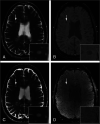7 Tesla and Beyond: Advanced Methods and Clinical Applications in Magnetic Resonance Imaging
- PMID: 34510098
- PMCID: PMC8505159
- DOI: 10.1097/RLI.0000000000000820
7 Tesla and Beyond: Advanced Methods and Clinical Applications in Magnetic Resonance Imaging
Abstract
Ultrahigh magnetic fields offer significantly higher signal-to-noise ratio, and several magnetic resonance applications additionally benefit from a higher contrast-to-noise ratio, with static magnetic field strengths of B0 ≥ 7 T currently being referred to as ultrahigh fields (UHFs). The advantages of UHF can be used to resolve structures more precisely or to visualize physiological/pathophysiological effects that would be difficult or even impossible to detect at lower field strengths. However, with these advantages also come challenges, such as inhomogeneities applying standard radiofrequency excitation techniques, higher energy deposition in the human body, and enhanced B0 field inhomogeneities. The advantages but also the challenges of UHF as well as promising advanced methodological developments and clinical applications that particularly benefit from UHF are discussed in this review article.
Copyright © 2021 The Author(s). Published by Wolters Kluwer Health, Inc.
Conflict of interest statement
Conflicts of interest and sources of funding: D.P. receives funding from the German Research Foundation (DFG; research grant project number 445704496). The other authors have no conflicts of interest and sources of funding to declare.
Figures








Similar articles
-
Cardiac Magnetic Resonance Imaging at 7 Tesla.J Vis Exp. 2019 Jan 6;(143). doi: 10.3791/55853. J Vis Exp. 2019. PMID: 30663648
-
[Problems and chances of high field magnetic resonance imaging].Radiologe. 2013 May;53(5):401-10. doi: 10.1007/s00117-012-2344-x. Radiologe. 2013. PMID: 23592011 German.
-
W(h)ither human cardiac and body magnetic resonance at ultrahigh fields? technical advances, practical considerations, applications, and clinical opportunities.NMR Biomed. 2016 Sep;29(9):1173-97. doi: 10.1002/nbm.3268. Epub 2015 Feb 23. NMR Biomed. 2016. PMID: 25706103 Review.
-
Multinuclear MRI at Ultrahigh Fields.Top Magn Reson Imaging. 2019 Jun;28(3):173-188. doi: 10.1097/RMR.0000000000000201. Top Magn Reson Imaging. 2019. PMID: 31188275 Review.
-
MRI of the Musculoskeletal System: Advanced Applications using High and Ultrahigh Field MRI.Semin Musculoskelet Radiol. 2015 Sep;19(4):363-74. doi: 10.1055/s-0035-1563735. Epub 2015 Nov 19. Semin Musculoskelet Radiol. 2015. PMID: 26583364 Review.
Cited by
-
Current approaches and advances in the imaging of stroke.Dis Model Mech. 2021 Dec 1;14(12):dmm048785. doi: 10.1242/dmm.048785. Epub 2021 Dec 7. Dis Model Mech. 2021. PMID: 34874055 Free PMC article. Review.
-
7 T and beyond: toward a synergy between fMRI-based presurgical mapping at ultrahigh magnetic fields, AI, and robotic neurosurgery.Eur Radiol Exp. 2024 Jul 1;8(1):73. doi: 10.1186/s41747-024-00472-y. Eur Radiol Exp. 2024. PMID: 38945979 Free PMC article. Review.
-
Test-retest stability of spontaneous brain activity and functional connectivity in the core resting-state networks assessed with ultrahigh field 7-Tesla resting-state functional magnetic resonance imaging.Hum Brain Mapp. 2022 Apr 15;43(6):2026-2040. doi: 10.1002/hbm.25771. Epub 2022 Jan 19. Hum Brain Mapp. 2022. PMID: 35044722 Free PMC article.
-
Novel 1H/19F double-tuned coil using an asymmetrical butterfly coil.Med Phys. 2025 Jul;52(7):e17890. doi: 10.1002/mp.17890. Epub 2025 May 19. Med Phys. 2025. PMID: 40387059 Free PMC article.
-
First application of dynamic oxygen-17 magnetic resonance imaging at 7 Tesla in a patient with early subacute stroke.Front Neurosci. 2023 Jun 15;17:1186558. doi: 10.3389/fnins.2023.1186558. eCollection 2023. Front Neurosci. 2023. PMID: 37404469 Free PMC article.
References
-
- Robitaille PM Warner R Jagadeesh J, et al. . Design and assembly of an 8 Tesla whole-body MR scanner. J Comput Assist Tomogr. 1999;23:808–820. - PubMed
-
- Bourekas EC Christoforidis GA Abduljalil AM, et al. . High resolution MRI of the deep gray nuclei at 8 Tesla. J Comput Assist Tomogr. 1999;23:867–874. - PubMed
-
- Burgess RE Yu Y Christoforidis GA, et al. . Human leptomeningeal and cortical vascular anatomy of the cerebral cortex at 8 Tesla. J Comput Assist Tomogr. 1999;23:850–856. - PubMed
-
- Vaughan JT Garwood M Collins CM, et al. . 7T vs. 4T: RF power, homogeneity, and signal-to-noise comparison in head images. Magn Reson Med. 2001;46:24–30. - PubMed
-
- Yacoub E Shmuel A Pfeuffer J, et al. . Imaging brain function in humans at 7 Tesla. Magn Reson Med. 2001;45:588–594. - PubMed
Publication types
MeSH terms
LinkOut - more resources
Full Text Sources
Medical

